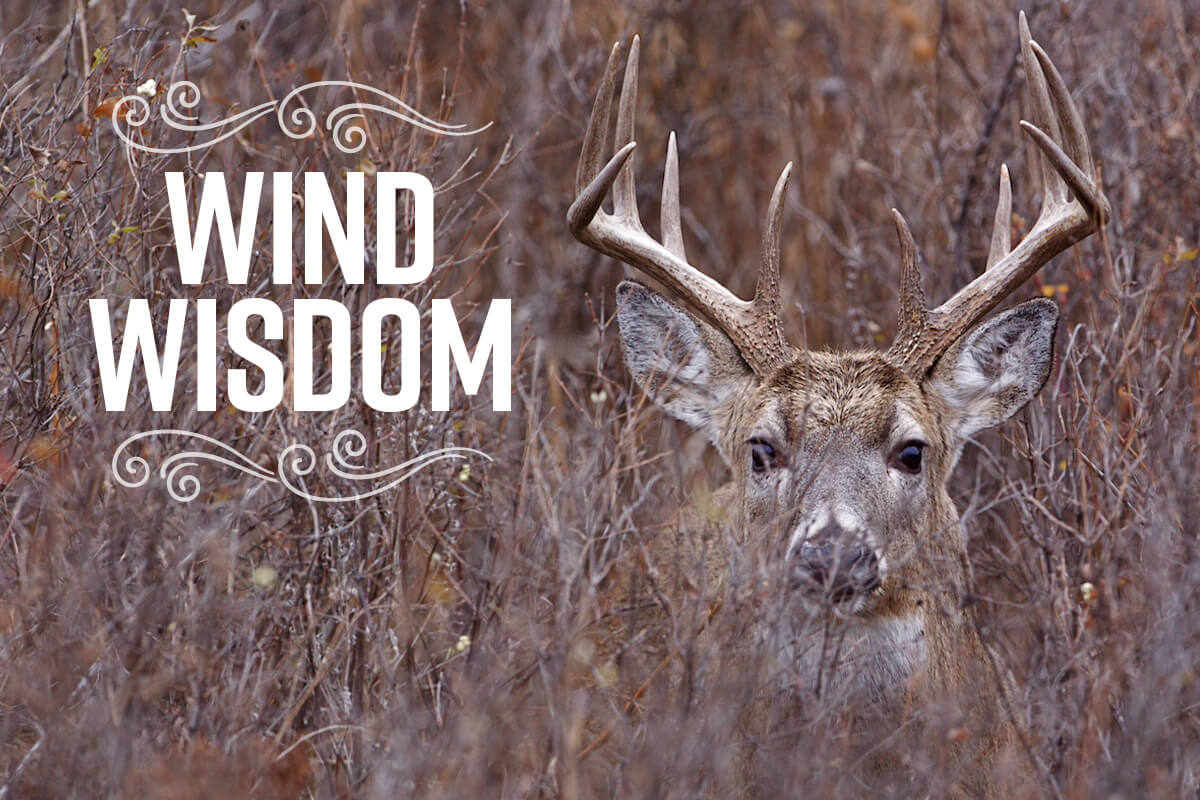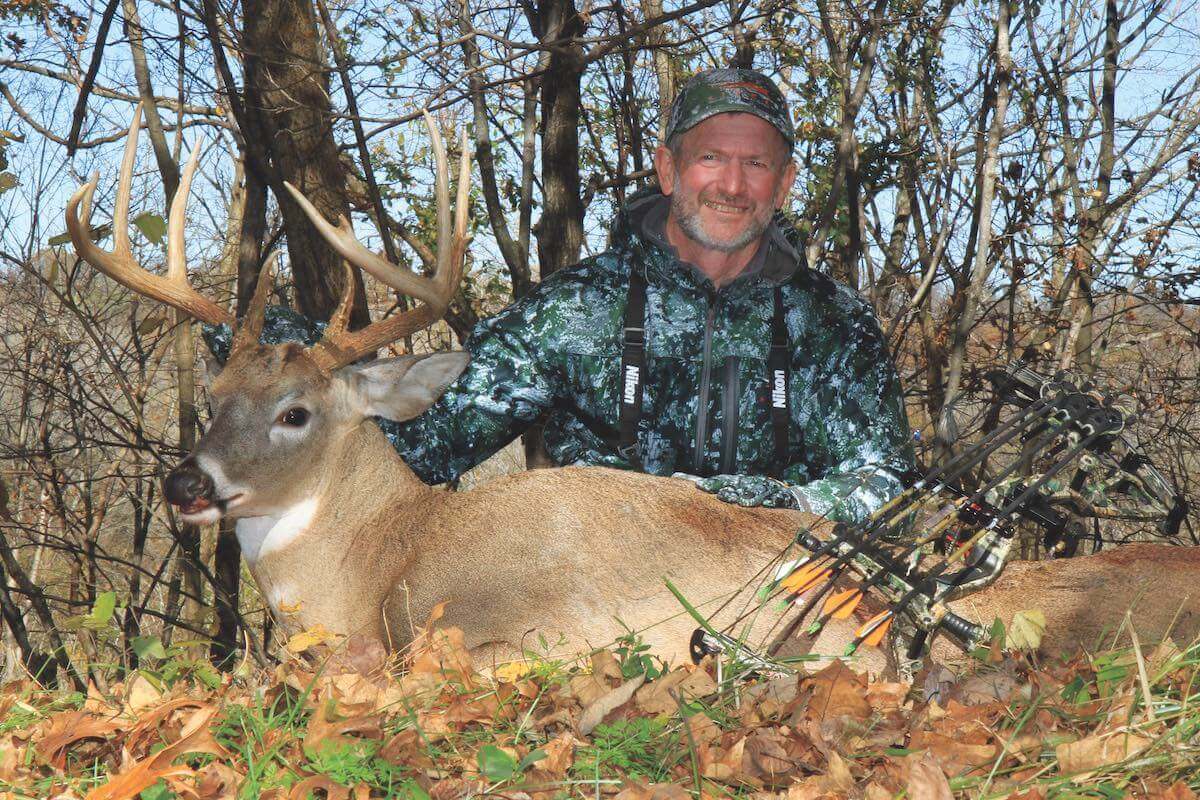
Many hunters believe deer don’t move on very windy days, but some academic studies have found the opposite to be true. (Shutterstock image)
Early deer seasons are characterized by warm, humid weather and the occasional front that rides in on a strong, sustained wind. For years, many deer hunters have believed that hunting on windy days is an exercise in futility. But is it?
On the days when the winds blow 20 mph or more, do deer stay hunkered down? If so, at what wind speed will they start moving again? If not, how fast must the wind blow to lock them down and make early season hunting a waste of time?
Over the years, I’ve found that most sportsmen who think hunting is horrible on windy days never hunt when a stiff wind is blowing. So, how do they know for sure if the field experience is at or near zero? Trail camera pictures? They only tell you so much. Perhaps whitetails do move, though primarily in sheltered areas and not as far as they do on calm days.

I’ve had success on days when the wind was really blowing, but usually only after adjusting both my location and technique. I find it’s hard (and not particularly safe) to sit 20 feet up a tree that’s swaying like the mast of a tall ship in a rough ocean. But that’s just me. So, what does the research say about deer movement on windy days?
THE SOUTH TEXAS STUDY
Back in 1984, two researchers, professor Steve Demarais of Texas Tech University and wildlife manager Bob Zaiglin, placed radio telemetry collars on 25 trophy-class bucks in South Texas. They collected data for four years, then analyzed how different wind speeds affected buck movement. In their study they broke down wind speed into different categories—0 to 4 mph, 5 to 9 mph, 10 to 14 mph, 15 to 19 mph and 20 mph-plus. They found that deer moved most in light winds, then dramatically declined their movement when wind speeds reached 15 to 19 mph. However, when the wind blew 20 mph or more, deer activity shot back up to the same level it was when winds were calm. Go figure. In this study, both calm and very windy days would have produced good hunting.
THE OKLAHOMA STUDY
Dr. Stephen Webb of Mississippi State University and colleagues conducted a multi-year study on whitetail movement, publishing their findings in 2010. In this study they placed GPS tracking collars on 17 female and 15 male deer in the Samuel Roberts Noble Foundation Wildlife Unit, a 2,999-acre spread in southern Oklahoma. The researchers found there were no discernible trends in the effects of the weather, including wind speed, on deer movement of either sex.
However, this study is somewhat inconclusive because buck movement was only monitored from November through February, and doe movement was tracked during the spring and summer months—not during fall hunting seasons.
THE CHESAPEAKE FARMS STUDY
One of the most-cited deer movement studies of the past several decades is the research conducted by James Weatherman Tomberlin entitled, “Movement, Activity and Habitat Use of Adult Male White-tailed Deer at Chesapeake Farms, Maryland.” The study was presented for his master’s thesis at North Carolina State University in 2007.
Tomberlin studied the effects of climactic factors like wind speed and wind direction on buck behavior from August to December. While he found that period of day and temperature were the most consistent predictors of adult male movement and activity across all seasons, he found no consistent effects of the wind on how far bucks traveled, leading him and his colleagues to conclude the wind plays no noticeable role in deer behavior.
THE PENNSYLVANIA STUDY
Penn State University student Leah Giralico completed an independent study that compared hunters’ beliefs about how the wind influences deer movements to data she and her colleagues collected on deer activity back in 2015.
To do so, Giralico surveyed more than 1,600 Pennsylvania hunters on their beliefs about how wind speed impacts whitetail movement. Nearly 90 percent of those surveyed said they believed deer move less on high-wind days. Next, Giralico and her colleagues looked at data they collected on deer movement in October 2013.
GPS units monitored how far 25 adult does and eight adult bucks traveled both day and night. Researchers were mainly looking at whether environmental factors like rain and wind speed influenced the distance either sex traveled. What they found was interesting.
“It took just a little bit of wind to get deer to move,” says Dr. Duane Diefenbach, leader and adjunct professor of Wildlife Ecology for the Pennsylvania Cooperative Fish and Wildlife Research Unit at Penn State University. “But it was usually warmer on calm days, so we can’t say for sure that it was wind speed that had the greatest effect on the distances deer traveled.”
Top wind speeds during the month of study were only about 12 mph, meaning researchers couldn’t determine how heavy winds influenced these deer. Interestingly, both male and female deer moved more during windy days, but less on windy nights.
The study also found that bucks increased their movements when a gentle wind was blowing, but only if it was not raining. A strong wind caused buck activity to increase significantly whether or not it was raining, but had no effect on does.
WHAT’S IT ALL MEAN?
These studies are obviously limited in scope. Therefore, while we can draw certain conclusions, nothing is really definitive. There’s nothing to say that deer studied in Pennsylvania or Oklahoma will react identically to those living in the Deep South. Also, these studies did not factor in hunting pressure and its relationship to the wind/deer movement connection. Statistical modeling is just that—a mathematical model that can never get inside an individual deer’s head.

Also, these studies focused on how far whitetails traveled and not why they traveled from one place to another. Just because some deer don’t move as far on windy days as they do on calm days doesn’t mean they are not moving.
Further examination, coupled with my own field experiences as well as those of other serious deer hunters I respect, just might show that windy days can be excellent days to hunt whitetails—if you know how and where.
Here’s something to think about: A study that shows that there has to be at least a little bit of a breeze to make deer comfortable to get up and moving makes sense when you think about how important their sense of smell is to them.
Windless days stymie scent movement making it more difficult for a deer to detect danger with their noses than on windy days. As a hunter always painstakingly aware of wind direction, breezy days make it easier to set up downwind of anticipated travel routes. The wind also eliminates thermal currents that can carry my scent down to a deer’s nose from my tree stand.
WINDBLOWN STRATEGIES
Make the most of a windy hunt with these tips.
On days it’s howling, I always hunt areas protected from the wind. These include the lee side of a ridge, the inside edge of a conifer swamp, back in tall timber and on trails leading from bedding thickets to preferred food sources.
Any thick area that slows down the wind is a potentially good spot to hunt. Interestingly, these same protected routes are also often the same ones used by mature bucks regardless of environmental conditions simply because they are places where it’s difficult for deer to be seen.
Winds that rock even the stoutest trees mean hunting from the ground for two reasons. The first is safety, of course, but high winds that sway your stand tree make it difficult, if not impossible, to make an accurate shot with either bow or gun. Tree stands are fine in a sheltered area, but I go to a ground blind—often a brush blind I build on the spot during run-and-gun hunting.
Even better, windy days are the perfect days to still hunt. With branches and leaves swirling about, it’s much harder for a deer to spot you than on a calm day. Move one step at a time and use your binocular to glass for pieces of bedded deer. Use topo maps and hunting apps to locate protected travel routes between bedding thickets and preferred food sources, then get in as tight as you can to the bedding area. The wind will help muffle any sound you make while dispersing your scent, making this a perfect time to hunt an area you might otherwise shy away from.










